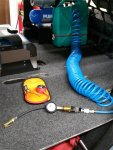Scoutn79
Adventurer
I had a smaller ARB portable which I finally installed under hood after 20 years,and hardwired (no tank). Then it died. Given it didn't really have much output I bought a new Viair rather than repair the ARB ... but somehow goofed on the dimensions and it won't fit where I had my ARB. So for now I'll probably keep it as a portable. My use is mostly for tire air-up. Anyway (get to the point), I had finally hard mounted the ARB underhood to save space and hide it from potential theft. Now that I'll need a new location, is hard-mounting really worth it for function, if you don't have horns or lockers? Seems I have more flexibility with a portable, and can get away with a shorter hose which could reduce air-up times (less pressure drop along the length of the hose). Curious to hear real-world pro's and con's. Thanks.
You could run a 100ft hose and have little issue with the air side of things and if all you are doing is airing up tires you won't even notice. You aren't flowing that much air. You could, however have issues with voltage running a long electrical lead to the pump. The pumps draw a lot of current and if you loose to many volts you will burn up the motor prematurely. You will likely need 6 gage wire, I am guessing here, to get 20ft to the pump.
Your choice how you mount it but I would have a good connection with the proper gage wire fore the length of run and amps required to feed the pump and keep it rather short and run a longer hose.
Plus copper is way more expensive, heavier and bulkier than an air hose.
Darrell





